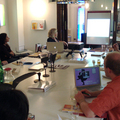Danese
— interview with President Carlotta de Bevilacqua and Marketing Manager Laura Salviati
About
DANESE was instrumental in defining the DNA of Italian design. Since 1957, the year of its founding, Danese's evolution has been dynamic and strongly innovative, a perfect fusion of design culture, creative research and production technique within not only a conceptual framework but also a concretely productive one expressed through simple objects of great quality. Danese's production embraces a range of archetypal objects whose age and style are hard to define.
"When I make something for Danese I take the view that it has to outlive the current design trend...the idea being that something that is relevant today will be relevant in three hundred years' time" says Enzo Mari, who, with Bruno Munari, designs pieces for Danese that create a sphere in which the article's anthropological function takes precedence over its intended use. Since 2000, Carlotta de Bevilacqua, president of Danese, has reasserted the firm's strategic positioning, creating innovation in continuity through a careful study of new generations of product concepts and new technologies with a focus on environmental quality. [Danese is] an absolute union that is supported by innovative, worldwide communication and distribution strategies. The quality of each process is an obligatory priority for a company that is always very sensitive to new scenarios: its headquarters and the showroom in Milan, considered benchmarks in Europe and the West, are now joined by the headquarters in Hong Kong, a privileged point of observation of the Far East. Sharing values is the base code of the formal, original designs that top international designers and architects produce for Danese, creating an experimental workshop where information and ideas help to open new design horizons.
With a catalogue that points in all directions, the whole Danese collection is composed of versatile objects divided into three main themes - LIVING, WORKING, LIGHTING - a modern answer to the relationship between people and their spaces
— excerpt from www.danesemilano.comInterview Ideas
Company
- When Carlotta De Bevilacqua bought the company she first analyzed the company and reaffirmed its identity.
- Great strides have been made in re-integrating itself back into market after a 10 year hiatus.
- Currently developing the use of e-Commerce to stimulate a new type of distribution network.
- From experience in Far East, Danese learned much and had to adapt and even back away from some of their initial ideas.
- Products have a cross-over and combination of everything which gives the company its edge.
- Idea of compactness in their products which allow easy storage, disassembly; also reflected in their packaging.
Main Ideas
- Designing in layers. Materials, functionality, aesthetics, and customizability are the composition of the object its value.
- Objects designed are not predefined, but open to a multiplicity of interpretations and use.
- Importance of understanding one's own approach to design and its relationship to the rest of the world.
- Design being the link for subject, object, and space.
- High quality, long lasting products create sustainability.
- Market is shifting towards a nomadic culture where experiences with an object can change from place to place.
- Difficulties with doing business in Far East since they have a different approach to business.
- Far East has high demand for exchanging to receive know-how.
- Different mentalities of a local culture can create problems when globalizing.
- Anti-copy solutions:
- Product is highly complex: a lot of technology, special assembly, etc.
- Product uses a new material.
- Product is meaningful and is more than its appearance: it has multiple "layers".
- Laura: The marketing of a design - how the design is perceived - is very important to its success.
- Opening up access to one's knowledge and ideas will allow you to integrate and create relationships with others and thus understand how to better design for them.
- Although closing off allows you to protect your "assets", those "assets" will become antiquated over time.
Video/Key Quotes
- The Hybridism of Good Design

- Europe's Business Relationship with Asia

- 'Authenticity' In Asia

- Open Network of Knowledge and Ideas

- Thoughtful Designs and Market Trends

- Change In Approach and Attitude

- Innovation, Understanding Needs

What We Learned
After she bought the company, Carlotta de Bevilacqua had to reassert the company from its declined position in the market. Doing critical analysis of the company allowed her to build a strong identity for the company and understand where to position Danese as well as how and why. Laura Salviati, Danese’s marketing and communications manager, spoke of how marketing is vital to the success of a design. Good design will only be accepted if the audience understands it and awareness of it is created.
Danese values the combination of many different things. It is these combinations and bricolages (a process where a design is made from a diverse range of components) that give Danese's products value. To be a designer is to have an understanding of multiple disciplines and have a variety of approaches.
With respect to the Far East, Carlotta has learned from experience that the culture and way of doing business there is very different than that of Europe. Good relations and benefits can be achieved from the Far East. However, understanding their needs and culture is the key to economic success in the Far East. Currently the development of the relationship between Italy and the Far East is only in its infancy.
In designing, Carlotta utilizes her knowledge of culture, history, trends, science and other experiences to understand the people she is designing for and fuse together this knowledge in advancing her company and creating exceptional designs. This is apparent when we interviewed her as she was able to accurately tie in the beliefs and history that she knew and observed in China to the mentality of the Chinese people today.
